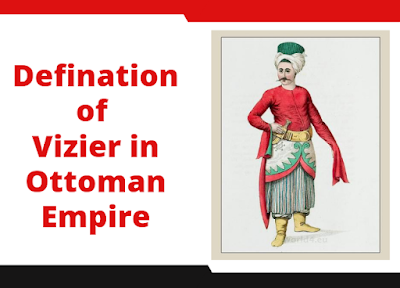Vizier: The title given to the highest-ranking civil servants who had extensive powers in the military and administrative fields in the Ottoman Empire. The word vizier in the lexicon means assistant, burden, and is the person who undertakes almost all the affairs of the sultan, who is the head of state, and helps him with his opinion and precautions in matters related to the monarchy. Viziers had four characteristics such as truthfulness, patience, fortitude and exaltation.
Hazrat Musa (AS) was the first to need the viziership, and he asked ALLAH Almighty to help him with his brother Harun ‘alaihis-salâm’. Our beloved Prophet had his viziers, that is, his assistants, especially Abu Bakr R.A The title of vizier began to be used for the first time in the Abbasid State, and later in various Islamic states. The Great Seljuks, Ilkhanids, Anatolian Seljuks and Ottomans also used this title.
First Vizier Title in Ottoman Empire:
In the Ottomans, the institution of viziership was formed for the first time with the appointment of a person with the title of vizier to the head of the divan organization established in the time of Orhan Ghazi (1324-1362). The first vizier was Alaaddin Pasha, who came from the ulema class, followed by Ahmed Pasha bin Mahmud, Haci Pasha and Sinaneddin Yusuf Pasha from the same class. Yûsuf Pasha was the last vizier of Orhan Gazi and the first vizier of Murâd-ı Hüdâvendigar. After his death, Sultan Murad Çandarlı brought Kara Halil to the vizierate. In this period, viziers were generally chosen from among the scholars of fiqh.
He was the only vizier in the time of Orhan Ghazi, and the divan; It consisted of three persons, namely the vizier, the kadi and the ruler. As the state grew and business increased, it was necessary to increase the number of viziers. Thus, one of the viziers whose numbers increased was appointed as the chief vizier (vizier). From the time of Kanuni Sultan Süleyman Han (1520-1566), the title of grand vizier was started to be used instead of grand vizier (See. Grand Vizier).
What is Vizier in Ottoman Empire:
In order to rise to the rank of vizier, excellent service, power and competence were sought. In order for a governor, also called Mir-i mîrân, to be a vizier, he had to be a Rumeli governor or a Rumeli emîrü’l-ümera after serving for a long time in the provinces as a sanjak-bey. However, he could pass from him to the vizierate.
Until the end of the reign of Suleiman the Magnificent, the number of viziers in the center did not exceed four. After that it increased to seven. Later, when the number of viziers increased even more, some important provinces (Baghdad, Budin, Yemen) were given to the viziers, apart from the dome viziership. Later, as this was not enough, the provinces were appointed from among the viziers, and finally, due to the excessive increase in the number of viziers, the provinces were divided and several sanjaks were combined and given to a vizier.

What was the role of the Vizier?
Those who were appointed to the viziership wore hil’at first in the presence of the sultan and then when they were accepted by the grand vizier. After that, the vezâret manşur or berat of the person appointed as the vizier is reîsulküttab; The engagement team was also picked up by the gunner and taken to his mansion. Due to these services, he would give legally specific and appropriate gifts to the new vizier reis Efendi, gunner, mir-i alam and sergeant.
The dome viziers used to sit to the right of the vizier during the divan meetings. When there was a lot of work in the Divan-ı Hümâyûn, the viziers of the dome would help the marksman by drawing the tughra with the permission of the grand vizier.
The dome viziers were sometimes appointed as seraskers or serdars. In such cases, a suitable number of janissaries, cebeci, artillery and cavalry soldiers from Kapıkulu soldiers would be given to his entourage. In addition, there was a treasurer or a treasurer in the office of a treasurer to deal with his financial affairs, and his own tezkire would act as reîsülküttab. Serdar used to establish a divan and listen to a lawsuit since the vizier movement. He had the authority over the dismissals and appointments in the regions he would go to with the people in his entourage. On his return, he would inform the Divan-ı Hümâyûn about his deeds.
Again, when the viziers went to the provinces with a duty, they had the authority to look into the cases and make decisions on the way until they went to the province. The same was true for the viziers returning to Istanbul. However, if he came to the province of a vizier, he would refer the case to him there.
Income and Facilities of a Vizier:
Viziers had great opportunities in terms of income, and their main sources of income were the gifts allocated to them. According to the Fatih code; The annual income of a vizier was one million two hundred thousand akches. As in other Turkish-Islamic states, they also took a share of the booty. The vizier was obliged to take one soldier to the expedition for every five thousand akçes of income of his vassal.
A vizier who was unable to serve due to his age, or whose administrative and military incapacity was proved by long experience, was given a certain amount of money from the mukataa of a locality or from another place.

If complaints were made about the viziers and the doubts about them were fixed, they were forced to reside in a certain place by taking the vizier’s signs and ranks from them. If it was heard that they were oppressing the people, they would be punished by judgment.
The Power Of Vizier:
There were at least three hundred people under the orders of the viziers who had large entourage. The crowd of this entourage, called the people of the door, was a measure showing the rank of the vizier.
Each vizier had a nine-floor mehterhane. But in this mehterhane, there was no Kös, which was a sign of being a sultan.
FootNotes:
- The History of Lütfi Pasha; sh. 453
- History of Civilization of Islam (C. Zeydan); vol-1, p. 132
- Târih-i Peçevi; vol-1, p. 485
- Central and Naval Organization of the Ottoman State; sh. 186 et al
- Grand Vizier in the Establishment Period of the Ottoman Empire (A. Taneri); sh. 40 ff
